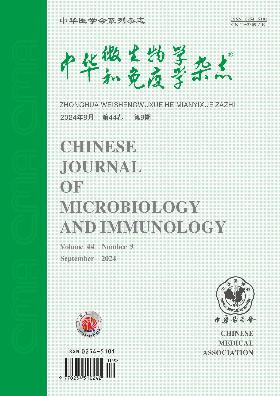肽基精氨酸脱亚胺酶4 (PAD4)在抗β2GP1/β2GP1复合物介导的中性粒细胞胞外陷阱形成中的作用
Q4 Immunology and Microbiology
引用次数: 0
摘要
目的探讨肽基精氨酸脱亚胺酶4 (PAD4)在抗β2GP1/β2GP1复合物诱导的中性粒细胞胞外捕获网络(NETs)形成中的作用。方法采用密度梯度离心法分离健康人外周血中性粒细胞。中性粒细胞与抗β2GP1/β2GP1复合物(100 μg/ml)孵育一定时间后,Western blot检测PAD4的表达。采用PAD4抑制剂cl -脒(10 μmol/L)预处理中性粒细胞。Western blot和ELISA检测各组大鼠蛋白水平上瓜氨酸组蛋白3 (CitH3)表达和髓过氧化物酶(MPO)-DNA相对含量的变化。采用下腔静脉狭窄建立小鼠抗磷脂综合征(APS)血栓模型。通过腹腔注射氨基氯(50 mg/kg)进行干预实验。Western blot检测血浆中CitH3蛋白水平的表达。荧光染色法测定血浆循环游离DNA (cf-DNA)浓度。收集下腔静脉血栓,加权评估抑制PAD4活性是否会抑制aps - igg诱导的NETs形成和血栓形成。组间差异分析采用t检验或单因素方差分析(ANOVA)。结果抗β2GP1/β2GP1复合物诱导的PAD4在细胞质中表达明显下调,在细胞核中表达升高[(3.67±0.32)vs(1.47±0.19),t=10.22, P<0.05;(0.57±0.19)vs(2.97±0.31),t=11.49, P<0.05。Cl-amidine显著抑制抗β2GP1/β2GP1复合物诱导的中性粒细胞表达CitH3蛋白[(2.46±0.47)vs(0.46±0.13),t=12.24, P<0.01],降低培养上清中MPO-DNA含量[(4.09±0.94)vs(2.80±0.57),t=4.23, P<0.05]。体内cl -脒显著抑制了APS小鼠血浆中CitH3蛋白的表达[(3.97±0.56)vs(1.09±0.45),t=11.83, P<0.01],降低了cf-DNA的含量[(2 685.0±735.8)vs(1 784.0±577.0),t=3.93, P<0.05]。与对照组实验APS小鼠相比,经cl -脒预处理的APS小鼠血栓重量明显减少[(8.22±3.06)vs(4.89±1.90),t=2.27, P<0.05]。结论PAD4参与抗β2GP1/β2GP1复合物诱导的NETs形成,可能在APS血栓形成中起重要作用。关键词:抗磷脂综合征;反-β2 gp1中/β2 gp1中复杂;中性粒细胞胞外陷阱;肽基精氨酸脱亚胺酶本文章由计算机程序翻译,如有差异,请以英文原文为准。
Role of peptidyl arginine deiminase 4 (PAD4) in anti-β2GP1/β2GP1 complex-mediated neutrophil extracellular trap formation
Objective
To investigate the role of peptidyl arginine deiminase 4 (PAD4) in anti-β2GP1/β2GP1 complex-induced formation of neutrophil extracellular trapping networks (NETs).
Methods
Peripheral blood neutrophils were isolated from healthy humans by density gradient centrifugation. PAD4 expression was detected by Western blot after the neutrophils were incubated with anti-β2GP1/β2GP1 complex (100 μg/ml) for a certain period of time. PAD4 inhibitor Cl-amidine (10 μmol/L) was used to pretreat neutrophils. Changes in the expression of citrullinated histone 3 (CitH3) at protein level and the relative content of myeloperoxidase (MPO)-DNA were detected by Western blot and ELISA, respectively. A mouse thrombus model of antiphospholipid syndrome (APS) was established by inferior vena cava stenosis. Intervention experiments were performed by intraperitoneal injection of Cl-amidine (50 mg/kg). The expression of CitH3 at protein level in plasma was detected by Western blot. The concentration of circulating free DNA (cf-DNA) in plasma was measured with fluorescent staining. Thrombus in inferior vena cava was collected and weighted to evaluate whether inhibiting the activity of PAD4 would suppress the APS-IgG-induced formation of NETs and thrombosis. Differences among groups were analyzed by t test or one-way analysis of variance (ANOVA).
Results
The expression of PAD4 induced by anti-β2GP1/β2GP1 complex was significantly down-regulated in the cytoplasm, but increased in the nucleus [(3.67±0.32) vs (1.47±0.19), t=10.22, P<0.05; (0.57±0.19) vs (2.97±0.31), t=11.49, P<0.05]. Cl-amidine significantly inhibited the anti-β2GP1/β2GP1 complex-induced expression of CitH3 protein by neutrophils [(2.46±0.47) vs (0.46±0.13), t=12.24, P<0.01], and reduced the MPO-DNA content in the culture supernatants [(4.09±0.94) vs (2.80±0.57), t=4.23, P<0.05]. In vivo, Cl-amidine significantly inhibited the expression of CitH3 protein [(3.97±0.56) vs (1.09±0.45), t=11.83, P<0.01] and decreased the content of cf-DNA [(2 685.0±735.8) vs (1 784.0±577.0), t=3.93, P<0.05] in plasma of APS mice. Compared with the experimental APS mice in the control group, the weight of thrombus in the APS mice pretreated with Cl-amidine was significantly reduced [(8.22±3.06) vs (4.89±1.90), t=2.27, P<0.05].
Conclusions
PAD4 was involved in the formation of NETs induced by anti-β2GP1/β2GP1 complex, which might play an important role in APS thrombosis.
Key words:
Antiphospholipid syndrome; Anti-β2GP1/β2GP1 complex; Neutrophil extracellular traps; Peptidyl arginine deiminase 4
求助全文
通过发布文献求助,成功后即可免费获取论文全文。
去求助
来源期刊

中华微生物学和免疫学杂志
Immunology and Microbiology-Virology
CiteScore
0.50
自引率
0.00%
发文量
6906
期刊介绍:
Chinese Journal of Microbiology and Immunology established in 1981. It is one of the series of journal sponsored by Chinese Medical Association. The aim of this journal is to spread and exchange the scientific achievements and practical experience in order to promote the development of medical microbiology and immunology. Its main contents comprise academic thesis, brief reports, reviews, summaries, news of meetings, book reviews and trends of home and abroad in this field. The distinguishing feature of the journal is to give the priority to the reports on the research of basic theory, and take account of the reports on clinical and practical skills.
 求助内容:
求助内容: 应助结果提醒方式:
应助结果提醒方式:


